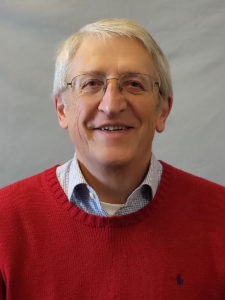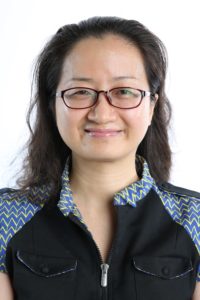Materials Horizons are delighted to welcome Professor Jean-Luc Brédas from the University of Arizona, USA as a Scientific Editor.
Professor Jean-Luc Bredas received his B.Sc. (1976) and Ph.D. (1979) degrees from the University of Namur, Belgium. In 1988, he was appointed Professor at the University of Mons, Belgium, where he established the Laboratory for Chemistry of Novel Materials. While keeping an “Extraordinary Professorship” appointment in Mons, he joined the University of Arizona in 1999. In 2003, he moved to the Georgia Institute of Technology where he became Regents’ Professor of Chemistry and Biochemistry and held the Vasser-Woolley and Georgia Research Alliance Chair in Molecular Design. Between 2014 and 2016, he joined King Abdullah University of Science and Technology (KAUST) as a Distinguished Professor and served as Director of the KAUST Solar & Photovoltaics Engineering Research Center. He returned to Georgia Tech in 2017 before moving back to the University of Arizona in 2020 where he is currently Regents Professor in the Department of Chemistry and Biochemistry. Jean-Luc Brédas is an elected Member of the International Academy of Quantum Molecular Science, the Royal Academy of Belgium, and the European Academy of Sciences. Recent honors include the 2013 American Physical Society David Adler Lectureship Award in the Field of Materials Physics, the 2016 American Chemical Society Award in the Chemistry of Materials, the 2019 Alexander von Humboldt Research Award, the 2020 Materials Research Society Materials Theory Award, and the 2021 Centenary Prize of the RSC. He is an Honorary Professor of the Institute of Chemistry of the Chinese Academy of Sciences and holds an Adjunct Professorship at the Georgia Institute of Technology. His Focus Article “Mind the Gap” is the first article that appeared in the very first issue of Materials Horizons.
Read our interview with Jean-Luc below.
1. What attracted you to pursue a career in materials science and how did you get to where you are now?
It was initially a love for chemistry, which grew into a passion for computational chemistry and organic chemistry. With organic materials becoming increasingly appealing because of their opto-electronic properties and broad range of applications, I gradually evolved into a computational materials scientist.
2. Why did you choose to specialize in your specific research field?
Because of a major scientific event that took place as I was starting my Ph.D.: The then-surprising discovery by Alan Heeger, Alan McDiarmid, and Hideki Shirakawa in late 1976 that organic polymers can be made highly electrically conducting, which led to the 2000 Nobel Prize in Chemistry. That discovery is what decided where I wanted to do my post-doc and everything else followed from there.
3. What do you see as the most important scientific achievement of the last decade?
Given the pandemic context, the development of m-RNA based vaccines springs to mind. In my field, the emergence of bio-organic electronics is very exciting as well as that of organic-inorganic hybrid perovskites.
4. What excites you most about your area of research and what has been the most exciting moment of your career so far?
The fact that the area of organic electronics and photonics combines the need for understanding of fundamental scientific processes with real-world applications: OLED displays are so cool!
5. Which of your Materials Horizons publications are you most proud of and why?
It turns out that I signed the very first article published by the journal in early 2014: “Mind the Gap”. It was a Focus Article, which many told me has been very useful to get clear ideas of the distinctions among band gap, optical gap, transport gap, etc.
6. Why do you feel that researchers should choose to publish their work in Materials Horizons?
Because of the journal’s high standards; because their work is initially assessed by scientific editors who are fellow active researchers; and because the journal highlights the new conceptual advances that the authors’ quality work brings forward.
7. What attracted you to join the Editorial Board of Materials Horizons?
I was a member of the original Editorial Advisory Board of the journal. I was seduced by the vision that the then Chair of the Editorial Board, Seth Marder, brought to what has become the flagship materials journal of the RSC. I am happy now to be in a position to contribute more directly.
8. The Materials Horizons team is delighted to welcome you to the Editorial Board. What are you most looking forward to when acting as a Scientific Editor for the journal?
What I hope to contribute is to a healthy growth of the journal where we strive to keep increasing its high standards, to make sure all members of the materials community are actively involved in its evolution, and to promote respect, diversity, and inclusion in everything we do for the journal.
9. What impact do you feel that your area of research can make over the next 10 years?
The application of organic optoelectronics on the bio side and its contributions to personalized medicine as well as to healthcare in developing countries. The appearance of organic solar cells out in the real world. The discovery of exotic quantum phases in purely organic π-conjugated materials.
10. What is your favourite reaction or material, and why?
I’ll have to say trans-polyacetylene, even though it is not a polymer that will have big-time applications given its instability. However, this is the material that arguably started the interest in the optoelectronic properties of organics. Also, the wealth of physics behind its deceivingly simple chemical structure is amazing!
11. Why should young people study chemistry or related subjects?
The events of the past two years as well as the dark issues facing our planet, make it more important than ever that the young generations embark on scientific studies, combined with the right political activism.
12. What is your biggest passion outside of science?
My family and soccer. It is a blast that both our daughters now live in Tucson and we can see them very often. Soccer-wise, it is nice to realize that the US are increasingly embracing the “beautiful game”; it’s comforting as well that “I’ll never walk alone”.
Submit to Materials Horizons now! Check out our author guidelines for information on our article types or find out more about the advantages of publishing in a Royal Society of Chemistry journal.
Keep up to date with our latest articles, reviews, collections & more by following us on Twitter, Facebook or by signing up to our E-Alerts.












